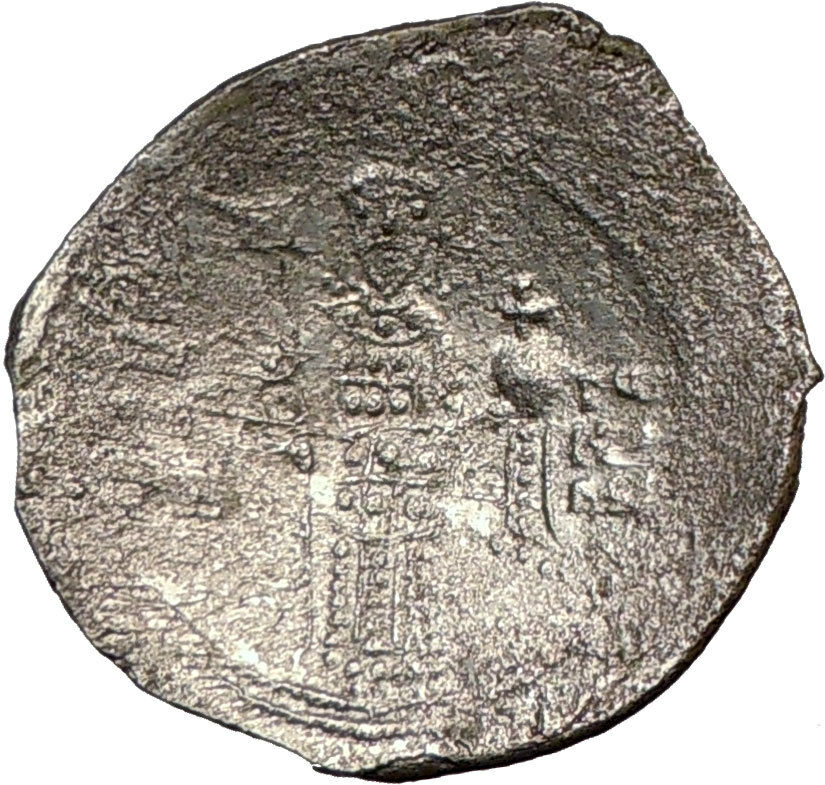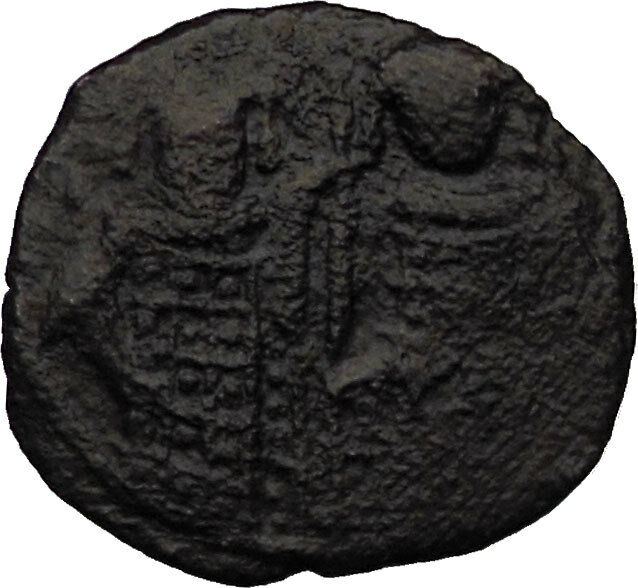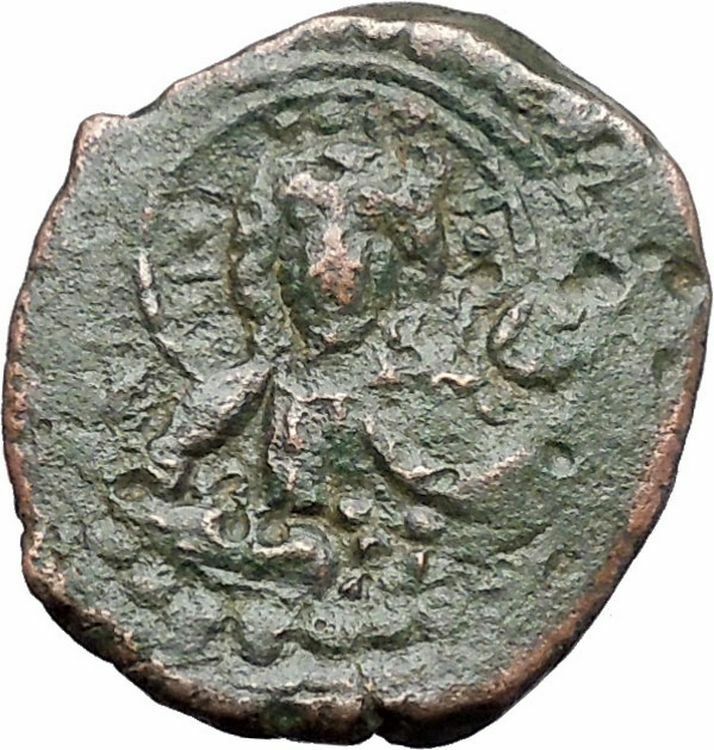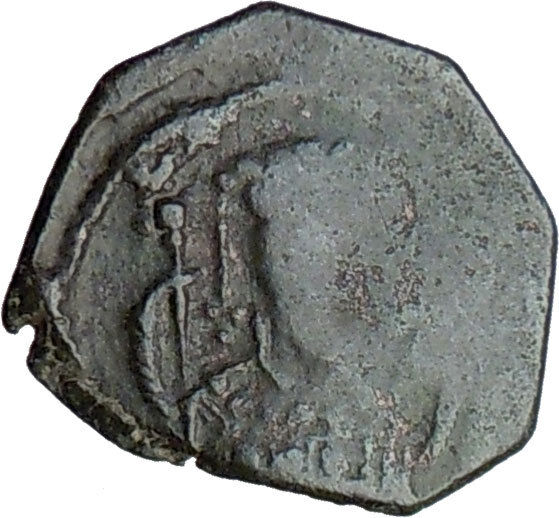|
Byzantine Empire
Michael II, the Amorian – Byzantine Emperor: December 25, 820 A.D. – October 2, 829 A.D.
with Associate Ruler: Theophilus – Augustus from May 12, 821 A.D.
Bronze Follis 30mm (6.9 grams) Constantinopolis mint, struck circa 821-829 A.D.
Reference: Sear 1642; DOC 10
MIXAHL S ΘЄOFILOS Facing busts of Michael II, bearded, wearing chlamys, on the left and Theophilus, beardless, wearing loros on the right, both wearing crown surmounted by cross; between their heads, cross.
Large M between X/X/X and N/N/N; above, cross; below, Θ.
You are bidding on the exact item pictured, provided with a Certificate of Authenticity and Lifetime Guarantee of Authenticity.
 Michael II the Amorian (Greek: Μιχαὴλ ὁ ἐξ Ἀμορίου, romanized: Michaēl ho ex Amoríou; 770–829), nicknamed the Stammerer (ὁ Τραυλός, ho Travlós or ὁ Ψελλός, ho Psellós), reigned as Byzantine Emperor from 25 December 820 to his death on 2 October 829, the first ruler of the Amorian dynasty. Michael II the Amorian (Greek: Μιχαὴλ ὁ ἐξ Ἀμορίου, romanized: Michaēl ho ex Amoríou; 770–829), nicknamed the Stammerer (ὁ Τραυλός, ho Travlós or ὁ Ψελλός, ho Psellós), reigned as Byzantine Emperor from 25 December 820 to his death on 2 October 829, the first ruler of the Amorian dynasty.
Born in Amorium, Michael was a soldier, rising to high rank along with his colleague Leo V the Armenian (r. 813–820). He helped Leo overthrow and take the place of Emperor Michael I Rangabe. However, after they fell out Leo sentenced Michael to death. Michael then masterminded a conspiracy which resulted in Leo’s assassination at Christmas in 820. Immediately he faced the long revolt of Thomas the Slav, which almost cost him his throne and was not completely quelled until spring 824. The later years of his reign were marked by two major military disasters that had long-term effects: the beginning of the Muslim conquest of Sicily, and the loss of Crete to the Saracens. Domestically, he supported and strengthened the resumption of official iconoclasm, which had begun again under Leo V.
.jpg) Theophilos (Greek: Θεόφιλος; sometimes Latinized or Anglicized as Theophilus or Theophilo; c. 812 – 20 January 842) was the Byzantine Emperor from 829 until his death in 842. He was the second emperor of the Amorian dynasty and the last emperor to support iconoclasm. Theophilos personally led the armies in his long war against the Arabs, beginning in 831. Theophilos (Greek: Θεόφιλος; sometimes Latinized or Anglicized as Theophilus or Theophilo; c. 812 – 20 January 842) was the Byzantine Emperor from 829 until his death in 842. He was the second emperor of the Amorian dynasty and the last emperor to support iconoclasm. Theophilos personally led the armies in his long war against the Arabs, beginning in 831.
At the time of his accession, Theophilos was obliged to wage wars against the Arabs on two fronts. Sicily was once again invaded by the Arabs, who took Palermo after a year-long siege in 831, established the Emirate of Sicily, and gradually continued to expand across the island. The defence after the invasion of Anatolia by the Abbasid Caliph Al-Ma’mun in 830 was led by the Emperor himself, but the Byzantines were defeated and lost several fortresses. In 831 Theophilos retaliated by leading a large army into Cilicia and capturing Tarsus. The Emperor returned to Constantinople in triumph, but in the autumn he was defeated in Cappadocia. Another defeat in the same province in 833 forced Theophilos to sue for peace (Theophilos offered 100,000 gold dinars and the return of 7,000 prisoners), which he obtained the next year, after the death of Al-Ma’mun.
During the respite from the war against the Abbasids, Theophilos arranged for the abduction of the Byzantine captives settled north of the Danube by Krum of Bulgaria. The rescue operation was carried out with success in c. 836, and the peace between Bulgaria and the Byzantine Empire was quickly restored. However, it proved impossible to maintain peace in the East. Theophilos had given asylum to a number of refugees from the east in 834, including Nasr, a Persian. He baptized one of the refugees, Theophobos, who married the Emperor’s aunt Irene and became one of his generals. As relations with the Abbasids deteriorated, Theophilos prepared for a new war.
In 837 Theophilos led a vast army of 70,000 men towards Mesopotamia and captured Melitene and Arsamosata. The Emperor also took and destroyed Zapetra (Zibatra, Sozopetra), which some sources claim as the birthplace of Caliph al-Mu’tasim. Theophilos returned to Constantinople in triumph. Eager for revenge, Al-Mu’tasim assembled a vast army and launched a two-pronged invasion of Anatolia in 838. Theophilos decided to strike one division of the caliph’s army before they could combine. On 21 July 838 at the Battle of Anzen in Dazimon, Theophilos personally led a Byzantine army of 25,000 to 40,000 men against the troops commanded by al-Afshin. Afshin withstood the Byzantine attack, counter-attacked, and won the battle. The Byzantine survivors fell back in disorder and did not interfere in the caliph’s continuing campaign.
Al-Mu’tasim took Ancyra, and al-Afshin joined him there. The full Abbasid army advanced against Amorium, the cradle of the dynasty. Initially there was determined resistance. Then a Muslim captive escaped and informed the caliph where there was a section of the wall that had only a front facade. Al-Mu’tasim concentrated his bombardment on this section, and the wall was breached. Having heroically held for fifty-five days, the city fell to al-Mu’tasim on 12 or 15 August 838.
In 838, in order to impress the Caliph of Baghdad, Theophilus had John the Grammarian distribute 36,000 nomismata to the citizens of Baghdad. In 839 or 840, he initiated diplomatic contact with the Umayyad Emirate of Córdoba. The name of his ambassador is somewhat garbled in the Arabic accounts of Ibn Hayyan, but it seems to have been the admiral Karteros. He was accompanied on his return by the Córdoban poet al-Ghazal, who signed a pact of friendship with Theophilos directed against the Abbasids.
Around 841, the Republic of Venice sent a fleet of 60 galleys (each carrying 200 men) to assist the Byzantines in driving the Arabs from Crotone, but it failed. During this campaign Al-Mu’tasim discovered that some of his top generals were plotting against him. Many of these leading commanders were arrested and some executed before he arrived home. Al-Afshin seems not to have been involved in this, but he was detected in other intrigues and died in prison in the spring of 841. Caliph al-Mu’tasim fell sick in October 841 and died on 5 January 842.
It is said that Theophilos, even though fighting the Arabs built a Baghdad-style palace near the Bosporus. In those days people went about a l’arabe in kaftans and turbans. Even as far as in the normal streets of Ghuangzhou during the era of Tang, the Arab-style kaftan was in fashion.
|





 Michael II the Amorian (Greek: Μιχαὴλ ὁ ἐξ Ἀμορίου, romanized: Michaēl ho ex Amoríou; 770–829), nicknamed the Stammerer (ὁ Τραυλός, ho Travlós or ὁ Ψελλός, ho Psellós), reigned as Byzantine Emperor from 25 December 820 to his death on 2 October 829, the first ruler of the Amorian dynasty.
Michael II the Amorian (Greek: Μιχαὴλ ὁ ἐξ Ἀμορίου, romanized: Michaēl ho ex Amoríou; 770–829), nicknamed the Stammerer (ὁ Τραυλός, ho Travlós or ὁ Ψελλός, ho Psellós), reigned as Byzantine Emperor from 25 December 820 to his death on 2 October 829, the first ruler of the Amorian dynasty..jpg) Theophilos (Greek: Θεόφιλος; sometimes Latinized or Anglicized as Theophilus or Theophilo; c. 812 – 20 January 842) was the Byzantine Emperor from 829 until his death in 842. He was the second emperor of the Amorian dynasty and the last emperor to support iconoclasm. Theophilos personally led the armies in his long war against the Arabs, beginning in 831.
Theophilos (Greek: Θεόφιλος; sometimes Latinized or Anglicized as Theophilus or Theophilo; c. 812 – 20 January 842) was the Byzantine Emperor from 829 until his death in 842. He was the second emperor of the Amorian dynasty and the last emperor to support iconoclasm. Theophilos personally led the armies in his long war against the Arabs, beginning in 831.




